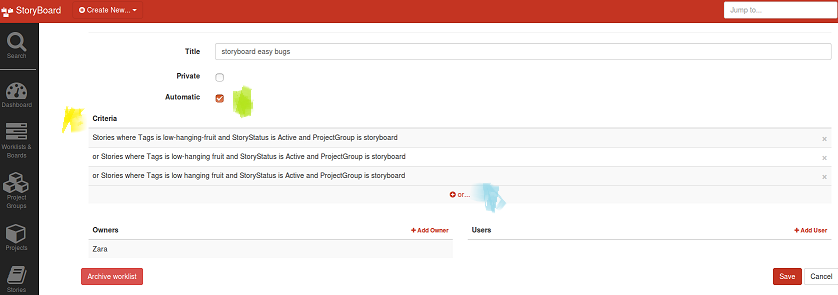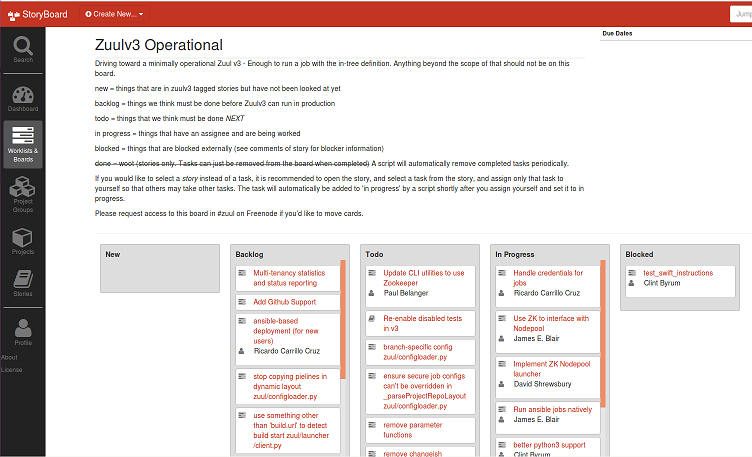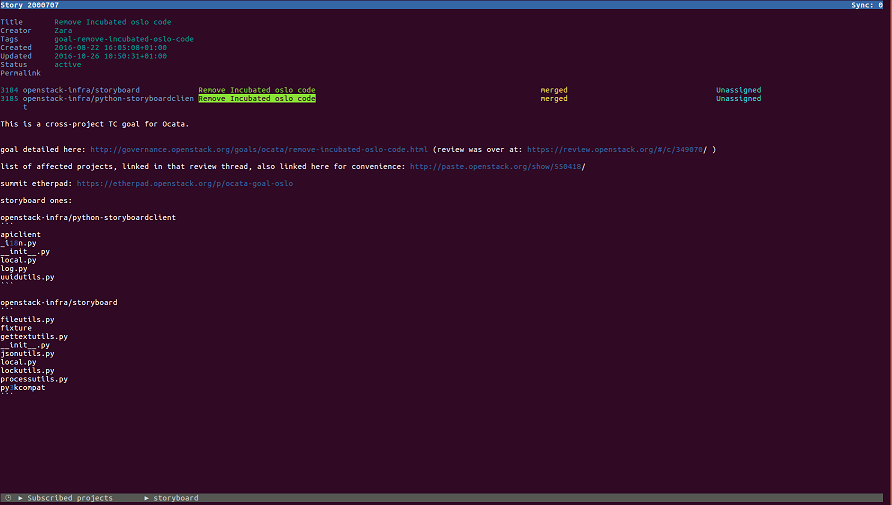Things that StoryBoard does differently¶
StoryBoard has been custom-designed to support collaboration within an open community with the following characteristics:
- The community manages a large number of projects, and some initiatives will span multiple projects.
- There are a variety of sponsors; no single organisation or person is in control of the community’s direction.
- Everyone is equally empowered to contribute.
- There are many stakeholders, who need to track diverse sets of requirements for each project.
- Even when requirements overlap, priorities can differ widely.
Consequently StoryBoard has several features built specifically around these needs.
If you’ve been using Launchpad on your project, by now you’re probably aware of its norms and idiosyncracies. It can be hard to envisage different ways of doing the same tasks when thinking in terms of things that are possible in Launchpad, so this document aims to give an overview of some of the interesting new features in StoryBoard that don’t have a Launchpad equivalent.
Moving beyond universal priorities¶
In StoryBoard, it’s possible for different people to say ‘this is a priority for us’, so that a task can have different priorities, tailored to different audiences.
So, why is this useful?
Traditional bug / task trackers have often modelled the concept of priority as a single, shared attribute field. For example, anyone could change a task’s priority, and this would be seen by everyone viewing the task. Typically there has been no way to say ‘you can only change this priority if you have discussed this on IRC and it has been agreed among the project team’, etc. This has meant that people with no context could alter global priority of tasks. Also, two different groups might prioritize tasks differently, and this could result in long prioritization sessions, where the real question was ‘whose priorities matter most?’ (and often the answer was ‘it depends on who the audience is’, so these arguments would result in a stalemate).
So, StoryBoard provides a way to say ‘this task matters to me’ or ‘this task matters to my team’, without trying to force that point of view on everyone else. We use worklists to express priority: if you manually add tasks to a worklist, you can drag and drop them in order of priority. This has the side effect that you can see how prioritizing one task affects the priority of other tasks; you can only have one item at the top, and putting anything high on the list will push other things down. It is possible for others to subscribe to the worklists of those individuals or teams whose priorities they care about; then, whenever they browse to a prioritised story, they will see if any of the tasks are on those lists, and what position the tasks are on the list.
Worklists have permissions, so it is possible to set up a project team list on which items can only be moved by contributors selected by core reviewers, etc. This stops everyone changing the priority of tasks without discussion.
This is still relatively new, and we’re excited to see how people use it. We’ve lost some ease in assigning priority in favour of finer grained representation of priority. In the past, StoryBoard did show lots of different people’s priorities, it just didn’t offer any way of tracking whose priorities were whose. So this makes things more open and explicit. We hope to tailor the implementation based on user feedback, and these are the first steps! :)
Worklists and Boards¶
StoryBoard introduces some new data models to meet the complex needs of OpenStack.
Worklists are arbitrary groupings of stories and/or tasks with whatever title the user wants. Each ‘item’ (story or task) is placed on a ‘card’ on the worklist. Here is an example:

A worklist can be handy as a personal todo list. Anyone can make a worklist, and the creator can decide who (if anyone) else can view and edit it. It is possible to either populate a worklist manually, or automatically populate it with stories or tasks that fulfil some criteria (eg: ‘assigned to Alice’. Here are some example filter criterai for an automatic worklist:

For more information about how to create and edit worklists, see this documentation.
We also have boards, which are akin to collections of worklists. Here’s an example:

You can name ‘lanes’ (lists) in the board what you want, and either populate them as a visualisation of some data by making them ‘automatic’ (like worklists, populate them with stories or tasks that meet some criteria), or manually move cards to and from non-automatic lanes. This means you can use boards to visualise data, or you can use them for a workflow like kanban if that’s your thing. So, for example, you might group various stories in different lanes according to criteria, and then the board would function as an ‘epic’, tracking the status of multiple stories. You can give a board a markdown description if you want to provide more detail on the background. You can even take a hybrid approach where you write custom scripts to move cards around based on certain conditions.
Permissions for boards work the same way as worklist permissions. A public board or worklist is visible to all, and editable for users and owners. A private board or worklist is only visible to its users and owners. Users can move and delete cards, but only owners can delete lanes or change the metadata of the board itself (eg: its title or description).
For documentation on how to create boards, add users/owners, etc that can be located here.
The REST API¶
StoryBoard has been developed with an API-first approach. What does this mean? Well, at its core, StoryBoard has a python API. This then plugs into a database, and can get information from it (or transmit information to it). The StoryBoard API can then be accessed from various clients, so that users can interact with some given database.
This means StoryBoard’s features are first built on the API side, and are then expressed in various clients. You can do more in the API than in any given UI, since the UI just expresses the API.
Why does that matter?
Custom scripts! Custom UIs! If you can express it in a script, you can fetch the data from StoryBoard. You don’t have to rely on features in any current UI if you have a niche request, and it’s possible to build your own new UI (or dashboard) if you want. You can also get info from the commandline on the fly with a tool like curl.
There are some docs to illustrate usage here:
https://docs.openstack.org/infra/storyboard/webapi/v1.html
Moreover, as the API is generally RESTful, it’s straightforward to guess how to do things, and compatible with a lot of other tools with minimal tinkering. Here are some sample, heavily commented scripts for one simple example (commandline) interface, a python client:
https://review.openstack.org/#/c/371620/
There is also a much more fully-featured and interactive commandline StoryBoard interface named boartty written by Jim Blair:

The long and short of it is, if you know how to display data from a REST API, you can display data from a StoryBoard instance.
You can do some fun things with this. For example, you could use
pygame if you wanted to depict stories as moving platforms or
something. On that note, if you feel like hacking something up, the
Storyboard team would love to hear from you! Come and say hello on
the #storyboard channel on Freenode IRC.
